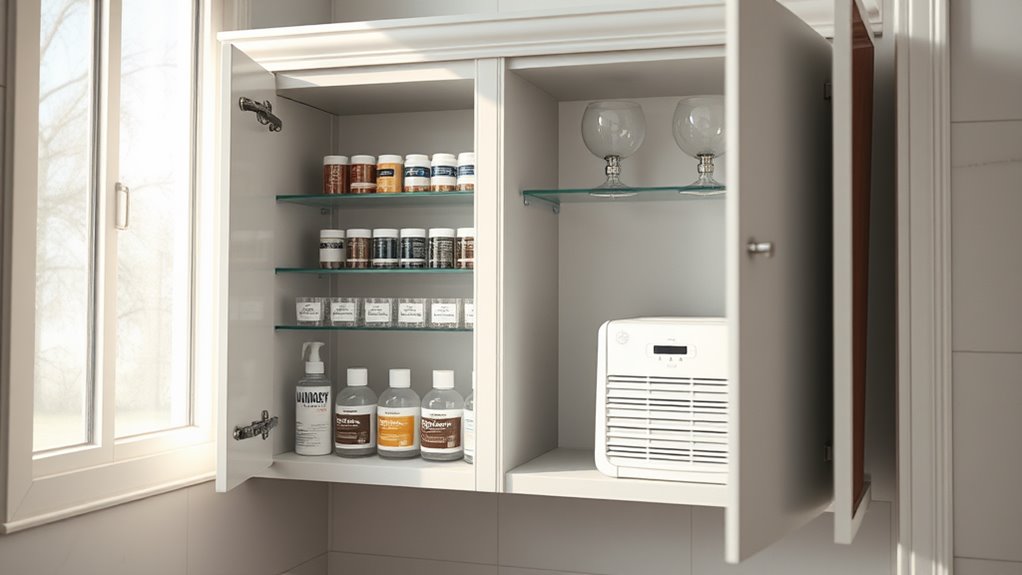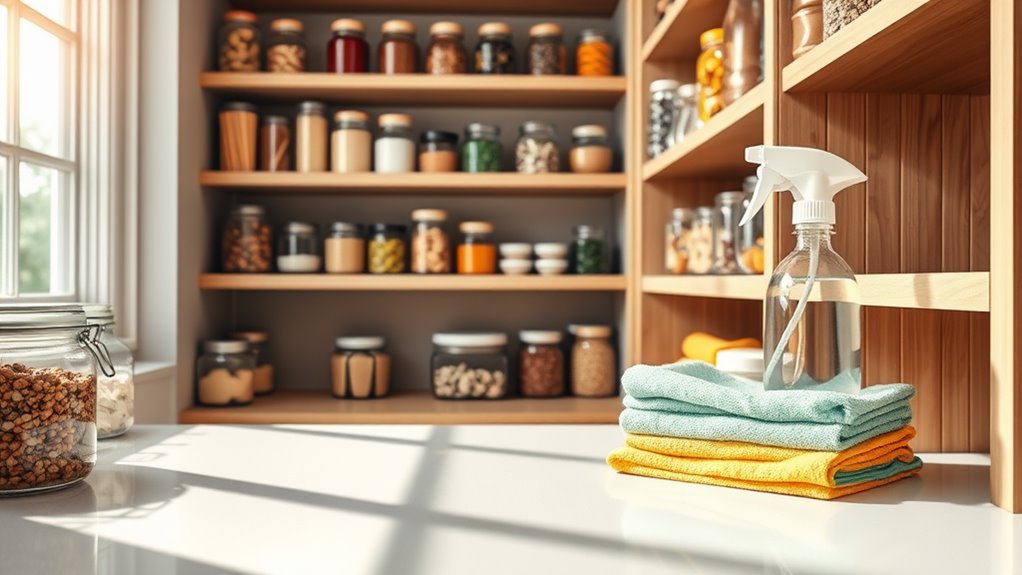My 15-Minute Weekly Routine That Keeps Clutter Away for Good
To keep clutter away for good, dedicate just 15 minutes each week. Start by creating a decluttering checklist and focus on one area at a time, like your kitchen counter or bedroom closet. Sort items into three categories: keep, donate, or discard. Use clear bins and labels to stay organized. By implementing this routine consistently, you’ll maintain a tidy space effortlessly. You’ll discover even more effective strategies to simplify your decluttering process.
Key Takeaways
- Dedicate 15 minutes each week to focus on high-traffic clutter hotspots, ensuring consistent maintenance of your space.
- Use a decluttering checklist to prioritize areas needing attention and set specific time limits for each task.
- Sort items quickly into three categories: Keep, Donate, or Discard, simplifying your decision-making process.
- Involve family members in your routine for shared responsibility, fostering a collaborative approach to maintaining order.
- Regularly revisit overlooked cleaning tasks to prevent clutter from accumulating and maintain an organized environment.
Setting Aside Your 15 Minutes
Setting aside just 15 minutes each day can make a significant difference in keeping your space clutter-free. This isn’t just a suggestion; it’s a powerful clutter routine that transforms chaos into order.
When you dedicate this short time, you’re actively engaging in the process of decluttering. Start by choosing a specific area—be it your desk, kitchen counter, or closet. Quickly sort through items, deciding what to keep, toss, or donate. Incorporating effortless decluttering into your routine can further enhance your efforts. The ten-minute tidy method can be a helpful tool in maximizing your efficiency during these short sessions. Additionally, utilizing smart tools can streamline your cleaning process, allowing for even greater effectiveness in your 15-minute routine.
By adopting a daily cleaning routine, you can create lasting habits that prevent clutter from accumulating over time. Focus on one task at a time to maintain clarity and efficiency. You’ll find that consistency is key; the more you practice this daily ritual, the more intuitive it becomes. Incorporating quick decluttering techniques into your routine can further enhance your efforts.
Before long, you’ll notice a remarkable shift in your environment, leading to a more serene and productive space.
Creating a Decluttering Checklist
To tackle clutter effectively, start by identifying those clutter hotspots in your home. Next, prioritize which areas need your attention the most, and set specific time limits for each task. This checklist will keep you focused and make decluttering feel more manageable. Additionally, consider implementing the one-in-one-out entryway system to further maintain a clutter-free environment. By consistently applying the one in, one out rule, you can ensure that your belongings remain under control and prevent future accumulation of clutter. Adopting a three-step approach can significantly enhance your decluttering efforts. One effective method to implement is the one-touch rule, which encourages making immediate decisions about items as you sort through them. To strengthen your decluttering mindset, regularly reflect on your emotional attachments to belongings, as this can help you make more intentional choices about what to keep or let go.
Identify Clutter Hotspots
Clutter hotspots can turn your home into a chaotic space if left unchecked. To master your environment, start by identifying areas where clutter tends to accumulate.
Examine your living space—kitchen counters, entryways, and bedrooms often serve as prime offenders. Make a checklist of these hotspots, noting common items that pile up, like mail, shoes, or unworn clothes.
Next, observe your habits. Are there specific times when clutter sneaks in? Recognizing patterns helps you stay proactive.
Set a weekly reminder to revisit your checklist, focusing on one hotspot at a time. By consistently identifying and addressing these areas, you’ll maintain a clearer, more organized space.
Take control of your environment, and watch clutter become a thing of the past.
Prioritize Decluttering Areas
While you might feel overwhelmed by the mess, prioritizing decluttering areas can make the process manageable. Start by creating a decluttering checklist to focus your efforts. Identify key spaces that need attention and rank them by importance. Here’s a simple table to guide you:
| Area to Declutter | Priority Level | Time Needed |
|---|---|---|
| Kitchen Counter | High | 15 minutes |
| Living Room Shelf | Medium | 10 minutes |
| Bedroom Closet | Low | 20 minutes |
Set Time Limits
Once you’ve prioritized the areas that need decluttering, it’s time to set time limits for each task. Break down your checklist into manageable chunks and assign a specific amount of time to each area.
For instance, allocate 10 minutes for your closet and 15 for the kitchen counter. This approach keeps you focused and prevents overwhelm. Use a timer to stay accountable; when the alarm rings, wrap up your task or shift to the next one.
Focusing on One Area at a Time
When tackling clutter, it’s smart to focus on one area at a time, starting with high-traffic zones like your living room or kitchen. Implementing efficient cleaning routines can help streamline your efforts and maximize productivity. Set time limits for each session to keep yourself motivated and on track. Regularly tackling overlooked cleaning tasks can also prevent clutter from accumulating in the first place. Consider using clear bins to make sorting and organizing a breeze, ensuring everything has a designated spot. Implementing a 5-bin sorting system can further enhance your organization efforts by providing a structured approach to decluttering. Additionally, incorporating innovative cleaning shortcuts can make your weekly routine even more effective. A well-planned weekly deep cleaning routine can also ensure that every corner of your home gets the attention it needs, making maintenance easier in the long run.
Prioritize High-Traffic Zones
To keep your home organized, it’s essential to tackle high-traffic zones one at a time. Start with areas that see the most activity, like the entryway, kitchen, or living room.
Focus on surfaces where clutter tends to accumulate, such as countertops and tables. Clear these spaces of unnecessary items, and designate specific spots for essentials.
As you work, assess what you truly need and what can be discarded or relocated. This approach not only creates an immediate visual impact but also sets a standard for other areas in your home.
Remember, maintaining organization in these key zones makes it easier to manage clutter throughout your space, fostering a more harmonious environment.
Prioritize and conquer!
Set Time Limits
Setting time limits can greatly enhance your decluttering efforts, as it encourages you to stay focused and efficient. By concentrating on one area at a time, you maximize your productivity and minimize distractions.
Here’s how to set effective time limits:
- Choose a specific area, like a drawer or a corner.
- Set a timer for 15 minutes to create urgency.
- Focus solely on that area until the timer goes off.
- Take a short break before moving to the next area.
This method not only keeps you motivated but also prevents overwhelm. With each focused session, you’ll see tangible progress, making it easier to maintain a clutter-free environment.
Use Clear Bins
Focusing on one area at a time helps streamline your decluttering process, and using clear bins can enhance this strategy.
Start by selecting a specific space, whether it’s a drawer, closet, or shelf. Grab a few clear bins to categorize items effectively. Label each bin to specify its contents—this way, you’ll know exactly where things belong.
As you sort through items, place each one into its designated bin. This method not only minimizes visual clutter but also makes it easier to identify what you have. With clear bins, you’ll maintain visibility of your belongings, ensuring you know when it’s time to reassess.
Commit to this practice weekly, and you’ll master the art of organization.
Sorting Items: Keep, Donate, Discard
Sorting items into three categories—keep, donate, and discard—can simplify the decluttering process.
This method helps you make decisions quickly and effectively, ensuring you only hold on to what’s truly valuable.
Here’s how to approach it:
-
Keep: Items you use regularly or have significant emotional value.
-
Donate: Gently used items that you no longer need but could benefit someone else.
-
Discard: Broken, damaged, or expired items that serve no purpose.
Organizing Storage Solutions
An effective storage solution can transform your space and keep clutter at bay. Start by identifying your storage needs and choose versatile options that suit your lifestyle. Utilize vertical space with shelves, and consider clear bins for visibility.
Here’s a quick visual guide to help you:
| Storage Type | Best Use Case |
|---|---|
| Baskets | Organizing loose items |
| Drawer Dividers | Separating small gadgets |
| Shelving Units | Maximizing vertical space |
| Clear Containers | Storing seasonal decor |
| Hooks | Hanging bags or tools |
Implementing a Weekly Maintenance Plan
While it might seem overwhelming at first, implementing a weekly maintenance plan can simplify your efforts to keep clutter under control. By dedicating just 15 minutes each week, you’ll establish a routine that prevents mess from piling up.
Here’s how to make it effective:
-
Choose a specific day and time. Consistency is key to building the habit.
-
Focus on high-traffic areas. Prioritize spaces that typically accumulate clutter, like the kitchen or living room.
-
Declutter as you go. Quickly assess items and decide whether to keep, donate, or discard.
-
Involve everyone. Encourage family members to participate, making it a shared responsibility.
With this structured approach, you’ll master clutter management and maintain a serene environment.
Celebrating Your Clutter-Free Space
Once you’ve successfully maintained a clutter-free space, it’s time to celebrate your achievement. Acknowledge the effort you’ve put in; this isn’t just about tidiness, but a transformation of your environment and mindset.
Take a moment to relish the clarity and calm your space brings. Consider rewarding yourself with a small treat—a favorite snack, an hour of your favorite hobby, or even a new plant to enhance your space.
Host a gathering to showcase your achievement, inviting friends to inspire them with your newfound order. Remember, each week you sustain this routine makes you a master of your environment.
Celebrate your growth and commitment, reinforcing the benefits of living clutter-free. You’ve earned it!
Frequently Asked Questions
How Do I Stay Motivated During My Decluttering Sessions?
To stay motivated during your decluttering sessions, set clear goals, celebrate small victories, and visualize your space’s potential. Break tasks into manageable chunks, and remind yourself of the freedom a clutter-free environment brings.
What if I Don’T Have 15 Minutes Every Week?
If you can’t spare 15 minutes weekly, break it down into smaller tasks. Even five minutes daily can make a difference. Consistency’s key, so find what works and stick to it, no matter the duration.
Can I Involve My Family in This Routine?
Involving your family can make the routine more effective and enjoyable. Assign specific tasks, set a timer, and celebrate your progress together. You’ll foster teamwork and create a cleaner, more organized home.
What Should I Do With Sentimental Items?
When dealing with sentimental items, decide which truly hold value for you. Consider photographing others before letting go. Create a dedicated space for cherished keepsakes, ensuring they’re appreciated without overwhelming your environment.
How Do I Prevent Clutter From Returning?
To prevent clutter from returning, regularly assess your belongings, establish designated spaces for items, and practice mindful acquisition. Stay disciplined in your routines, and you’ll maintain a serene, organized environment that supports your lifestyle.



